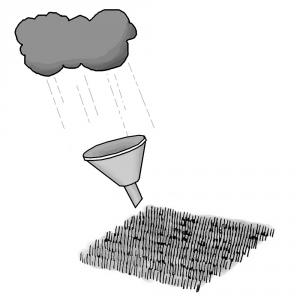Stormwater management means to manage surface runoff. It can be applied in rural areas (e.g. to harvest precipitation water), but is essential in urban areas where run-off cannot infiltrate because the surfaces are impermeable. Traditional stormwater management was mainly to drain high peak flows away. Unfortunately, this only dislocates high water loads. Modern approaches aim to rebuild the natural water cycle, i.e. to store runoff water (e.g. retention basins) for a certain time, to recharge ground water (e.g. infiltration basins) and to use the collected water for irrigation or household supply. Costs depend on technology and the size of the systems. Planning, implementation and operation and maintenance require expert knowledge.
| Entradas | Salidas |
|---|---|
Stormwater management is essential to prevent erosion of agricultural land and flooding of inhabited urban or rural areas. Both cases can cause severe damages and contamination of the environment if sanitation facilities are flooded. This results in high costs and notably massive suffering for the local communities.
Stormwater in Rural Areas

In rural areas, the cumulative impact of countryside living subdivisions, roads and buildings causes an increase in peak flow rates, and the volume of water that is discharged after storm events. This leads to 2 key effects: flooding and stream erosion (ARC 2010). The main problem in rural areas is impermeable surfaces (e.g. caused by roads and buildings) and overstrained sewer systems (see PPT). In rural areas and agricultural land it can lead to erosion (see also 2050-soil degradation]).
Furthermore, this water could be used for agriculture and drinking water. Beside techniques that can be implemented in rural and urban areas (read more below), there are specific tools for rural areas and agriculture land. These include irrigation systems, called spate irrigation, or small-scale precipitation techniques such as micro basins, gully plug, field trenches, bunds, dams and of course rooftop harvesting. All of these techniques make use of important water sources while also reducing peak flows during rainy periods, storing water, and attenuating the power and velocity of floods.
Stormwater Management in Urban Areas

Any urban development will affect or make an impact on its environment. Construction of roads or buildings significantly changes the hydraulic properties of an area. Typically, pervious layers are rendered less permeable or even impermeable. Depressions are raised to prevent ponding. Surfaces and conduits are constructed to drain runoff more efficiently. Natural vegetation is often removed, causing reduced interception and transpiration by plants. Limited vegetation cover exposes the soil to the impact of rain, which may lead to increased erosion. Natural meandering watercourses may be canalised to more effectively route flows through the development. Stormwater management is the science of limiting these negative impacts on the environment and enhancing the positive impacts, or catering for the hydraulic needs of a development while minimising the associated negative environmental impacts (CSIR 2000).
Because of the impermeable surfaces in urban areas, flooding occurs very often as a human-made event. Runoff from such surfaces has a high velocity, which adds to stormwater drainage systems. This increases peak flow and overland flow volume and decreases natural groundwater flow (as no is percolation possible) and evapotranspiration. Furthermore, urban runoff has an increased pollution load, which leads to water pollution (PARKINSON et al. 2010).
The traditional model of stormwater management is based on a misconception. It aims the draining of urban runoff as quick as possible with the help of channels and pipes (see also sewer systems (see PPT)), which increases peak flows and costs of stormwater management. This type of solution only transfers flood problems from one section of the basin to another section. Urban runoff contains a large amount of solids and a higher concentration of metals and other toxic components (PARKINSON et al. 2010).
A more sustainable approach is Integrated Urban Water Management (IUWM), which refers to the practice of managing freshwater, wastewater, and stormwater as links within the resource management structure, using an urban area as the unit of management (UNEP 2009). IUWM includes the following activities:
- Improve water supply and consumption efficiency
- Ensure adequate water quality for drinking water as well as wastewater treatment through the use of Environmentally Sound Technologies (ESTs) and preventive management practices
- Utilise alternative water sources, including rainwater and reclaimed and treated water
- Engage communities to reflect their needs and knowledge for water management
- Establish and implement policies and strategies to facilitate the above activities
- Support capacity development of personnel and institutions that are engaged in IUWM
- Improve economic efficiency of services to sustain operations and investments for water, wastewater, and stormwater management
New technologies for stormwater development in the sense of IUWM have been developed since the 1970s and include detention and retention ponds, permeable surfaces, infiltration trenches, surface and surbsurface groundwater recharge, and other sources control measures (PARKINSON et al. 2010).
Detention Ponds
Detention ponds are excavated reservoirs or constructed in natural depressions, which are dry during low flow periods. They provide temporary storage of stormwater runoff attenuation for both stormwater quality and quantity management. To ensure the pollution removal role, ponds must be designed to allow stormwater to sit long enough to settle out the solids (PARKINSON et al. 2010; NJDEP 2004).
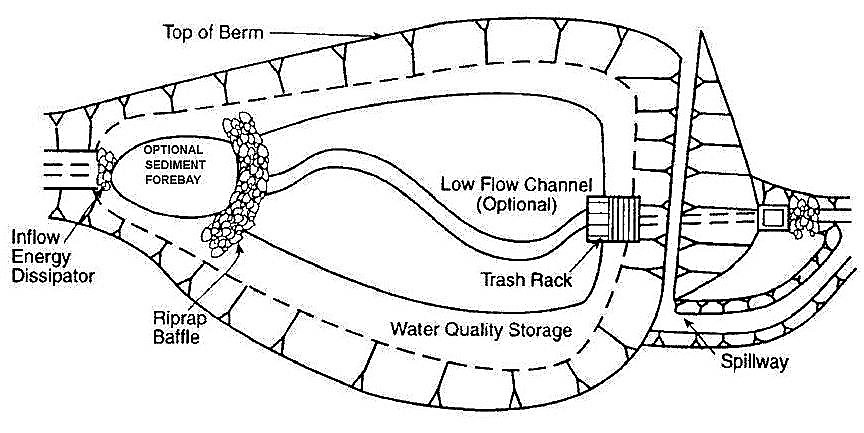
Retention Ponds
Retention ponds (see also retention basins) are primarily designed to improve the quality of water from stormwater flows, but are often employed as flood control devices. They are designed not to dry out during dry periods, thus retaining water permanently as a part of their volume. The basic design parameter is the residence time, generally between 2 and 4 weeks. Water quality improvement occurs mainly through settling (PARKINSON et al. 2010).
Onsite Detention (OSD)
On-site Stormwater Detention (OSD) is a way of collecting the rain that falls on a site (known as stormwater or surface run-off), storing it temporarily, and then releasing it slowly so that it doesn’t worsen downstream flooding. It is mostly used in urban and residential areas and can be retrofitted in existing buildings (PARKINSON et al. 2010; UPRCT n.y.).
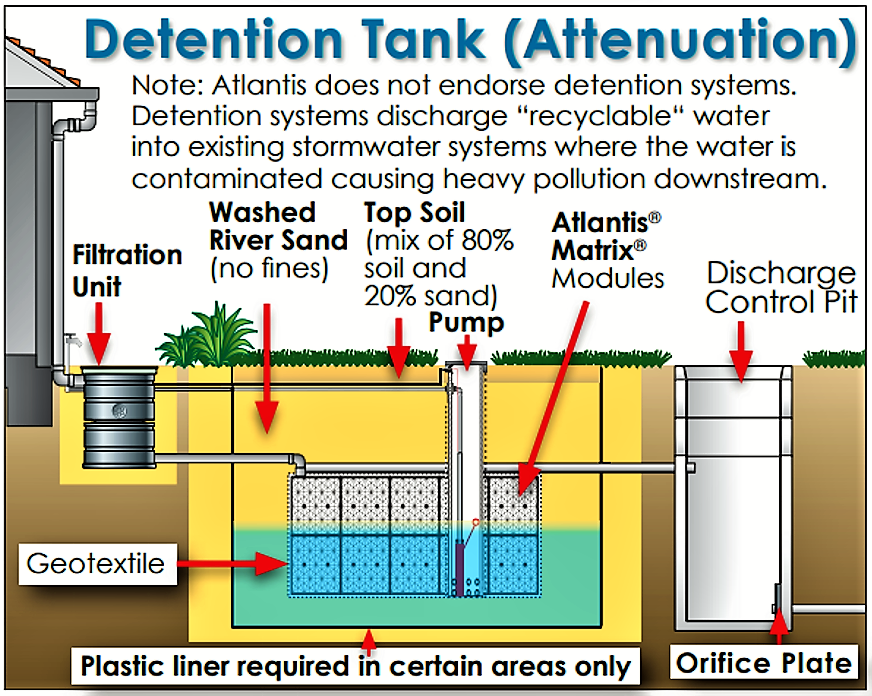
Rainwater Harvesting
Interest in adapting rainwater harvesting in urban areas is increasing as it provides the combined benefits of conserving potable water and reducing stormwater runoff. When harvested rainwater is used to irrigate landscaped areas, the water is either evapotranspired by vegetation or infiltrated into the soil, thereby helping to maintain predevelopment water balance. The rain that falls upon a catchment surface, such as a roof, is collected and conveyed into a storage tank. With minimal pre-treatment (e.g., gravity filtration or first-flush diversion), the captured rainwater can be used for outdoor non-potable water uses such as irrigation and pressure washing, or in the building to flush toilets or urinals (adapted from TRCA & CVC 2010). It is also a widely used useful technique in rural areas.
Green Roofs
Green roofs, also known as “living roofs” or “rooftop gardens”, consist of a thin layer of vegetation and growing medium installed on top of a conventional flat or sloped roof. Green roofs are touted for their benefits to cities, as they improve energy efficiency, reduce urban heat island effects, and create green space for passive recreation or aesthetic enjoyment. Green roofs or vertical gardens can also be irrigated with treated greywater for instance. To a water resources manager, they are attractive for their water quality, water balance, and peak flow control benefits. From a hydrologic perspective, the green roof acts like a lawn or meadow by storing rainwater in the growing medium and ponding areas. Read more about it in TRCA & CVC (2010).
Constructed Wetlands
Beside constructed wetlands (e.g. horizontal flow) for wastewater treatment, there are also engineered stormwater wetlands to manage flood peaks, improving water quality of surface run-off and restoring some of the cities natural habitat and birdlife (AUCKLAND CITY COUNCIL (2010). Read more about these wetlands in METROCOUNCIL (n.y.). They can be combined with surface and subsurface groundwater recharge systems or soil aquifer treatment.
Infiltration Trenches
Infiltration trenches are shallow excavations that are filled with uniformly crushed stone (similar to soak pits) to create underground reservoirs for stormwater runoff. The runoff gradually exfiltrates through the bottom of the trench into the subsoil and eventually into the water table. The walls and the top are lined with geotextile to avoid sediment penetration. Trench designs may be modified to include vegetative cover and other features, establishing a bio-filtration area. They are often constructed beside outdoor parking lots or beside streets. Treatment occurs during infiltration into the soil. However, there is a risk of clogging where sedimentation concentration in runoff is high (DEP & CZM 1997; PARKINSON et al. 2010).
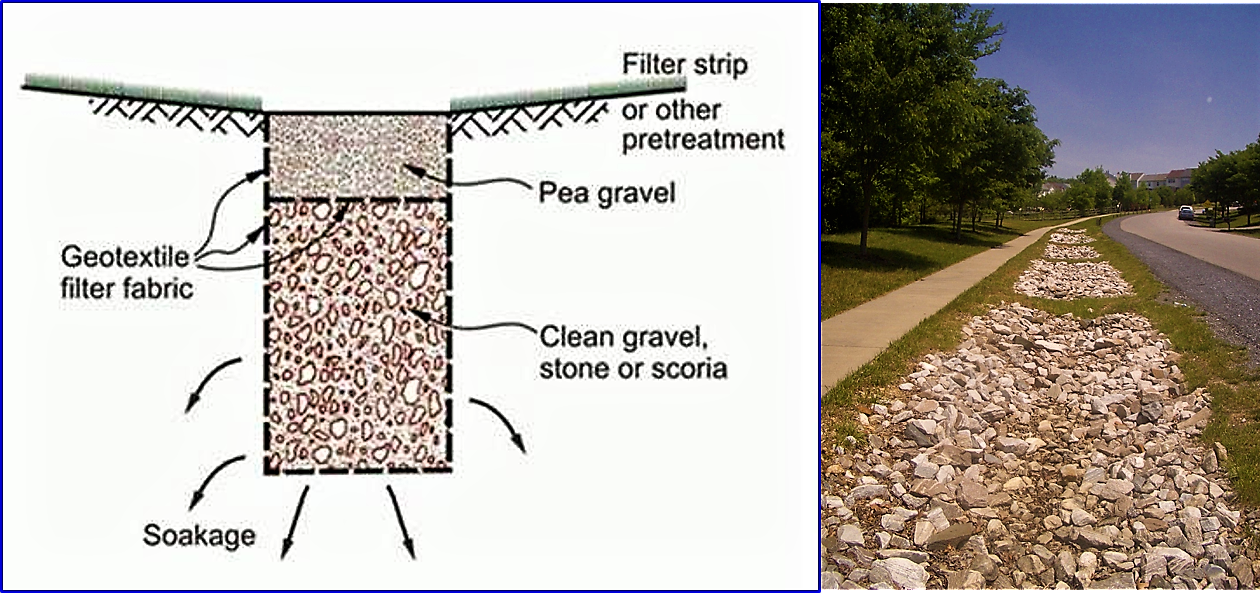
Grass Filter Stripes
Grass filter stripes (also known as filter stripes or grassed filters) are densely vegetated, uniformly graded areas that treat surface flow from adjacent impervious areas. Grass filter stripes function by slowing runoff velocities, trapping sediment and other pollutants and providing a modest infiltration (BARR ENGINEERING COMPANY 2001).
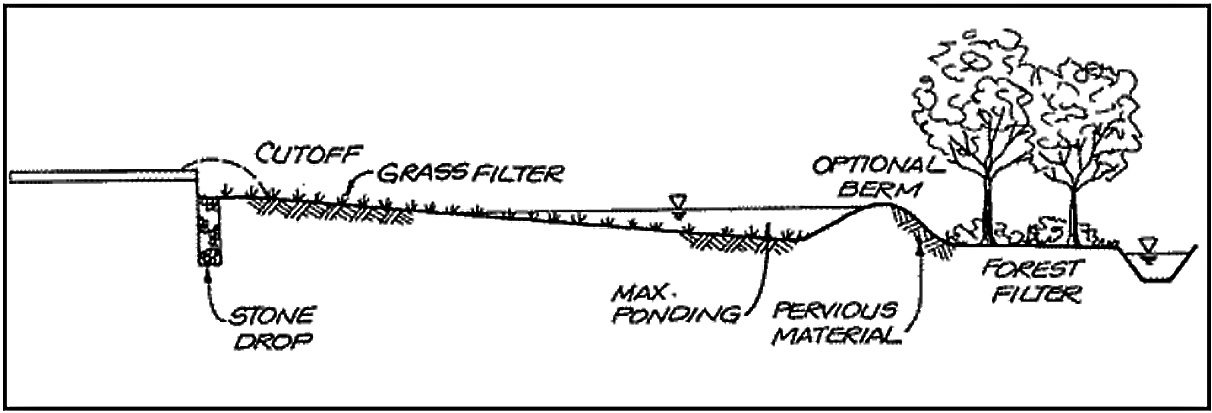
Grassed Swales
Grass swales (also called vegetated swales) are open grassed channels in which stormwater runoff is slowed down and partially infiltrated along their course. Check dams and vegetation in the swale slow the water to allow sedimentation, filtration through the root zone and soil matrix, evapotranspiration, and infiltration into the underlying native soil. Simple grass channels or ditches have long been used for stormwater conveyance, particularly for roadway drainage. Enhanced grass swales incorporate design features such as modified geometry and check dams that improve the contaminant removal and runoff reduction functions of simple grass channel and roadside ditch designs (PARKINSON et al. 2010; TRCA & CVC 2010).
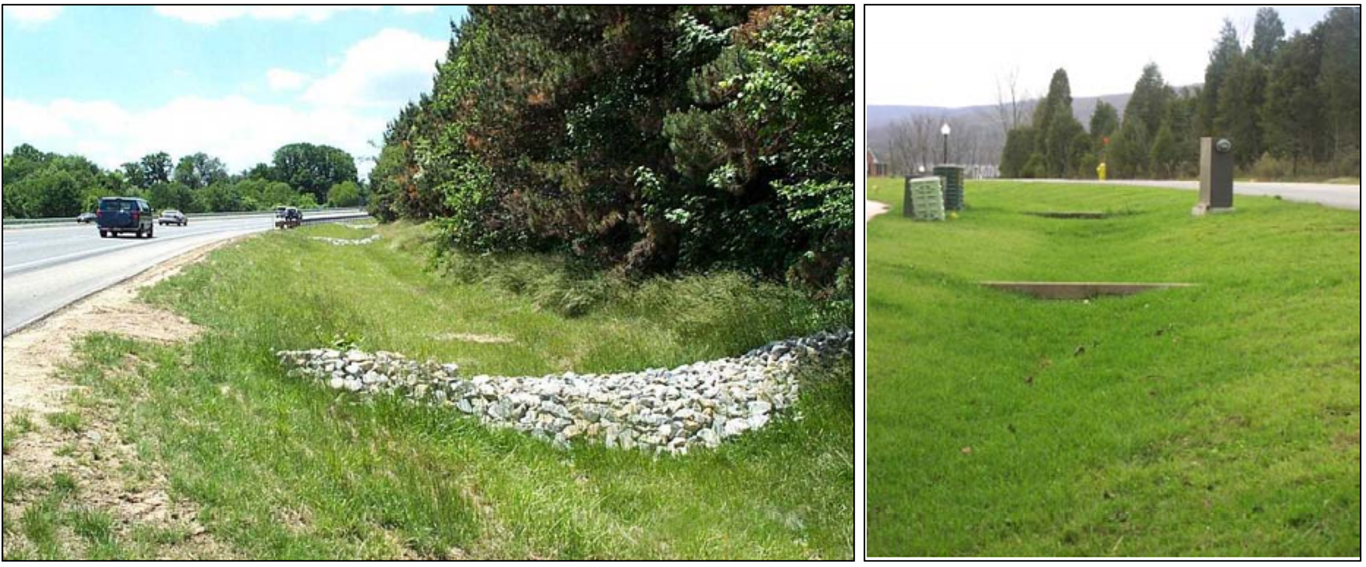
Pervious Pavements
Pervious pavement is a permeable pavement surface with a stone reservoir underneath. The reservoir temporarily stores surface runoff before infiltrating it into the subsoil or sub-surface drainage and in the process improves the water quality. Porous materials such as ancient lime mortars and pervious pavements are made using relatively mono graded materials. In the case of pervious pavement this translates as a lack of "fine" materials. Pervious pavement is also sometimes also referred to as “no fines concrete” (adapted from TECOECO n.y.).
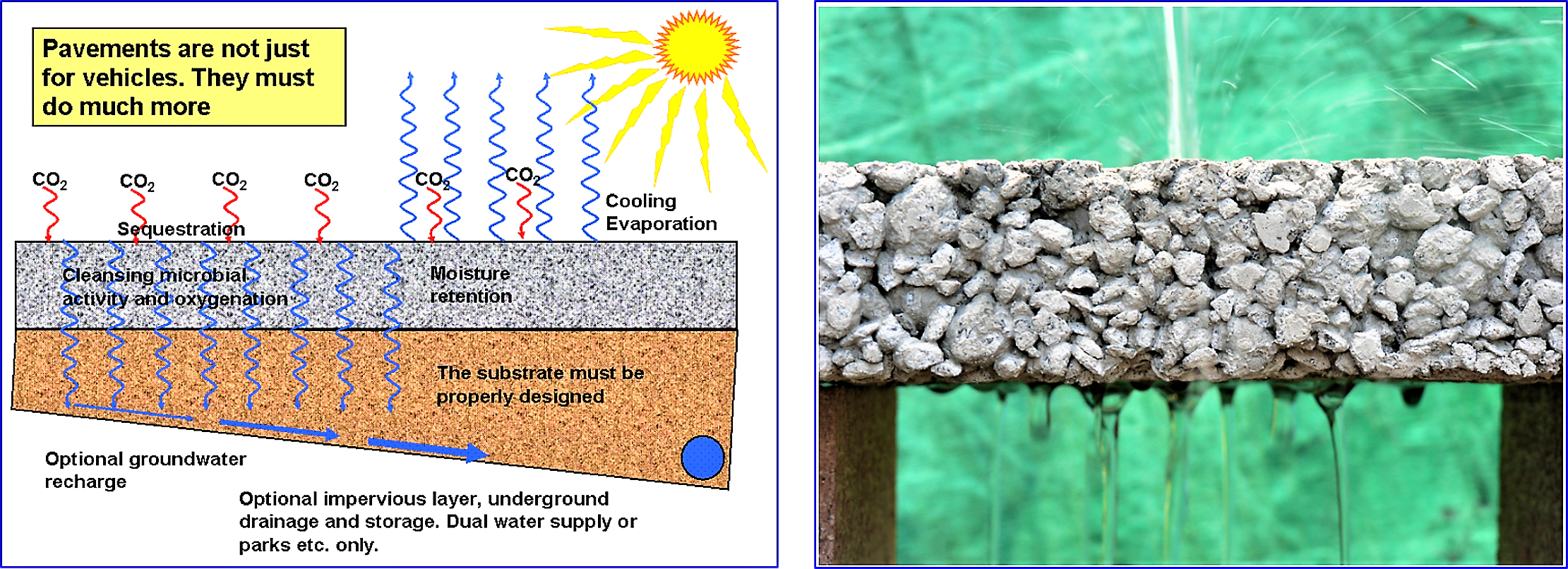
Infiltration Basin
An infiltration basin (also called infiltration pond) is a facility constructed within highly permeable soils that provides temporary storage of stormwater runoff (see also surface groundwater recharge). An infiltration basin does not normally have a structural outlet (like detention basins) to discharge runoff from the stormwater quality design storm. Instead, outflow from an infiltration basin is through the surrounding soil. An infiltration basin may also be combined with an extended detention basin to provide additional runoff storage for both stormwater quality and quantity management. The adopted TSS removal rate for infiltration basins is 80 per cent (NJDEP 2004).
The costs of the different systems depend very much on the technology, topography and expert knowledge. Some of them are quite easy to implement, others are very complex and raise the costs. On the other hand, a proper stormwater management avoids damages on infrastructure and protects the population of urban areas and rural settlements.
Modern stormwater techniques mostly have some ecological treatment effects with the general aim to protect the health, welfare and safety of the public (by preventing water pollution), and to protect property from flood hazards by safely routing and discharging stormwater from developments (CSIR 2000).
A problem for the public health, but also for the proper function of the stormwater facilities, can be urban solid waste. Legal and illegal domestic sewer connections to stormwater drainage systems mean that ancillaries, such as retention basins, become pollutant traps. During high floods, these are washed out and can lead to water contamination (PARKINSON et al. 2010).
Furthermore, high loads of fine sediments can clog infiltration systems, leading to permanent ponding. This can result in mosquito breeding, which is a major problem in humid climates where malaria and other tropical diseases are common.
All stormwater management systems need a proper O&M service. Regular maintenance extends the life of stormwater systems, improves site drainage, and reduces pollution entering surface waters and groundwater. Governmental facilities as well as private property owners are responsible for O&M. As an example, a manual for private owners can be found in CITY OF PORTLAND (2006).
Theoretically, stormwater management is necessary in every settlement, rural or urban, to protect human health, prevent water pollution, (re-)use precipitation water (on agriculture or household level) and prevent damages to infrastructure. It is essential in urban areas where constructed surfaces change the hydraulic properties and prevent infiltration. The whole management has to be adapted to the local conditions (climate, topography, resources, etc.). Therefore, expert knowledge is required.
Modular Underground Tanks System
The Atlantis underground tank system is a modular sub surface system that can be constructed to hold any volume required. The sub surface location of the tank frees up space for landscaping or driveway use while also ensuring optimal conditions for retaining water is always maintained. Macro and micro pollutants are completely kept out of the system through an Atlantis Filtration Unit. It is used for infiltration, detention and to store roof top harvested rainwater.
ATLANTIS (n.y): Modular Underground Tanks System. Sidney: Atlantis URL [Visita: 09.05.2019]The Countryside Living Toolbox: A Guide for the Management of Stormwater Discharges in Countryside Living Areas in the Auckland Region
The guideline document (the “Toolbox”) is intended to provide the above mentioned groups with a selection of methods and tools to mitigate the effects of stormwater run-off from countryside living areas. All these councils are committed to a policy of avoiding, remedying or mitigating the adverse effects from stormwater discharges on the receiving environment to the greatest extent possible.
ARC (2010): The Countryside Living Toolbox: A Guide for the Management of Stormwater Discharges in Countryside Living Areas in the Auckland Region. Auckland: Auckland Regional Council (ARC) URL [Visita: 09.05.2019]Stormwater Management Guidelines for the Province of Alberta
These guidelines are intended to help municipalities, local authorities, consulting engineers, and developers in the planning and design of stormwater management systems in Alberta. They outline the objectives of stormwater management and the available methodologies and concepts for the planning, design, and operation of stormwater drainage systems. In addition to the water quantity aspects of stormwater management, the publication also describes some of the techniques that can be applied for quality management of stormwater.
ALBERTA ENVIRONMENT (1999): Stormwater Management Guidelines for the Province of Alberta. Edmonton: Alberta Environmental Protection URL [Visita: 09.05.2019]Stormwater
Urban Small Sites Best Management Practice Manual. Filter Stripes
This paper includes the most important points about grass filter stripes. It contains a general description, advantages, construction and design and O&M devices.
BARR ENGINEERING COMPANY (2001): Urban Small Sites Best Management Practice Manual. Filter Stripes. St. Paul: Metropolitan Council Environmental Services. [Accessed: 28.02.2012] PDFOperation and Maintenance for Private Property Owners
This handbook will help you maintain your stormwater management facility to make sure it performs the work it is designed to accomplish.
CITY OF PORTLAND (2006): Operation and Maintenance for Private Property Owners. Portland: Environmental Services URL [Visita: 05.03.2012]Guidelines for Human Settlement Planning and Design
This manual, Guidelines for Human Settlement Planning and Design, provides a guiding vision for South African settlement formation, addressing the qualities that should be sought after in our human settlements, and providing guidance on how these can be achieved. The publication has been developed over a period of more than two years through a participative process in which stakeholders and experts from various disciplines were involved.
CSIR (2000): Guidelines for Human Settlement Planning and Design. Pretoria: CSIR Building and Construction Technology, Vol II, Chapter 6, pp.1-39 URL [Visita: 09.05.2019]Stormwater Management
This manual about stormwater management includes the three main topics “Hydrology and Stormwater Runoff”, “Site Planning and Nonstructural Approaches” and “Structural Best Management Practices”.
DEP ; CZM (1997): Stormwater Management. Volume Two: Stormwater Technical Handbook. Boston: MA Department of Environmental Protection (DEP) and MA Office of Coastal Zone Management (CZM) URL [Visita: 09.05.2019]Operation and Maintenance for Private Property Owners
This handbook will help you maintain your stormwater management facility to make sure it performs the work it is designed to accomplish.
CITY OF PORTLAND (2006): Operation and Maintenance for Private Property Owners. Portland: Environmental Services URL [Visita: 05.03.2012]Guidelines for Human Settlement Planning and Design
This manual, Guidelines for Human Settlement Planning and Design, provides a guiding vision for South African settlement formation, addressing the qualities that should be sought after in our human settlements, and providing guidance on how these can be achieved. The publication has been developed over a period of more than two years through a participative process in which stakeholders and experts from various disciplines were involved.
CSIR (2000): Guidelines for Human Settlement Planning and Design. Pretoria: CSIR Building and Construction Technology, Vol II, Chapter 6, pp.1-39 URL [Visita: 09.05.2019]Stormwater Management
This manual about stormwater management includes the three main topics “Hydrology and Stormwater Runoff”, “Site Planning and Nonstructural Approaches” and “Structural Best Management Practices”.
DEP ; CZM (1997): Stormwater Management. Volume Two: Stormwater Technical Handbook. Boston: MA Department of Environmental Protection (DEP) and MA Office of Coastal Zone Management (CZM) URL [Visita: 09.05.2019]New Jersey Stormwater Best Management Practices Manual: Chapter 9.5 - Standard for Infiltration Basins
The New Jersey Stormwater Best Management Practices Manual (BMP manual) is developed to provide guidance to address the standards in the proposed Stormwater Management Rules. Chapter 9.5: Standard for Infiltration Basins.
NJDEP (2004): New Jersey Stormwater Best Management Practices Manual: Chapter 9.5 - Standard for Infiltration Basins. New Jersey: Department of Environmental Protection URL [Visita: 28.02.2012]New Jersey Stormwater Best Management Practices Manual: Chapter 9.4 - Standard for Extended Detention Basins
The New Jersey Stormwater Best Management Practices Manual (BMP manual) is developed to provide guidance to address the standards in the proposed Stormwater Management Rules. Chapter 9.4 - Standard for Extended Detention Basins.
NJDEP (2004): New Jersey Stormwater Best Management Practices Manual: Chapter 9.4 - Standard for Extended Detention Basins. New Jersey: Department of Environmental Protection URL [Visita: 28.02.2012]Integrated Urban Water Management: Humid
Infiltration Trenches
Infiltration Trenches SSM
Permecocrete
An article about pervious pavement and its possibilities.
TECOECO (n.y): Permecocrete. Glenorchy: TecEco Pty Ltd. URL [Visita: 05.03.2012]Low Impact Development Stormwater Management Planning and Design Guide
The guide is intended to provide engineers, ecologists and planners with up-to-date information and direction on landscape-based stormwater management planning and low impact development stormwater management practices such as rainwater harvesting, green roofs, bioretention, permeable pavement, soakaways and swales. The information contained in the guide will help practitioners adopt landscape-based stormwater management approaches, and will help select, design, construct and monitor more sustainable stormwater management practices.
TRCA ; CVC (2010): Low Impact Development Stormwater Management Planning and Design Guide. Downsview and Mississauga: Toronto and Region Conservation Authority (TRCA) and Toronto and Region Conservation Authority (CVC) URL [Visita: 09.05.2019]Integrated Urban Water Management.
What is On-site Stormwater Detention?
A nice paper, illustrated with different pictures, about the possibilities of on-site detention.
UPRCT (n.y): What is On-site Stormwater Detention? . Parramatta: Upper Parramatta River Catchment Trust (UPRCT) URL [Visita: 09.05.2019]Stormwater Management Guidelines for the Province of Alberta
These guidelines are intended to help municipalities, local authorities, consulting engineers, and developers in the planning and design of stormwater management systems in Alberta. They outline the objectives of stormwater management and the available methodologies and concepts for the planning, design, and operation of stormwater drainage systems. In addition to the water quantity aspects of stormwater management, the publication also describes some of the techniques that can be applied for quality management of stormwater.
ALBERTA ENVIRONMENT (1999): Stormwater Management Guidelines for the Province of Alberta. Edmonton: Alberta Environmental Protection URL [Visita: 09.05.2019]The Countryside Living Toolbox: A Guide for the Management of Stormwater Discharges in Countryside Living Areas in the Auckland Region
The guideline document (the “Toolbox”) is intended to provide the above mentioned groups with a selection of methods and tools to mitigate the effects of stormwater run-off from countryside living areas. All these councils are committed to a policy of avoiding, remedying or mitigating the adverse effects from stormwater discharges on the receiving environment to the greatest extent possible.
ARC (2010): The Countryside Living Toolbox: A Guide for the Management of Stormwater Discharges in Countryside Living Areas in the Auckland Region. Auckland: Auckland Regional Council (ARC) URL [Visita: 09.05.2019]Modular Underground Tanks System
The Atlantis underground tank system is a modular sub surface system that can be constructed to hold any volume required. The sub surface location of the tank frees up space for landscaping or driveway use while also ensuring optimal conditions for retaining water is always maintained. Macro and micro pollutants are completely kept out of the system through an Atlantis Filtration Unit. It is used for infiltration, detention and to store roof top harvested rainwater.
ATLANTIS (n.y): Modular Underground Tanks System. Sidney: Atlantis URL [Visita: 09.05.2019]Urban Small Sites Best Management Practice Manual. Filter Stripes
This paper includes the most important points about grass filter stripes. It contains a general description, advantages, construction and design and O&M devices.
BARR ENGINEERING COMPANY (2001): Urban Small Sites Best Management Practice Manual. Filter Stripes. St. Paul: Metropolitan Council Environmental Services. [Accessed: 28.02.2012] PDFStormwater Management in Monwabisi Park
This guidebook developed specifically to Monwabisi Park, South Africa, this book can be used as a guideline for stormwater management in other informal settlements with similar physical and social conditions.
BUTTON, K. JEYARAJ, E. MA, R. MUNIZ, E. (2010): Stormwater Management in Monwabisi Park. C-Section Worcester: Worcester Polytechnic Institute URL [Visita: 25.05.2012]Operation and Maintenance for Private Property Owners
This handbook will help you maintain your stormwater management facility to make sure it performs the work it is designed to accomplish.
CITY OF PORTLAND (2006): Operation and Maintenance for Private Property Owners. Portland: Environmental Services URL [Visita: 05.03.2012]Guidelines for Human Settlement Planning and Design
This manual, Guidelines for Human Settlement Planning and Design, provides a guiding vision for South African settlement formation, addressing the qualities that should be sought after in our human settlements, and providing guidance on how these can be achieved. The publication has been developed over a period of more than two years through a participative process in which stakeholders and experts from various disciplines were involved.
CSIR (2000): Guidelines for Human Settlement Planning and Design. Pretoria: CSIR Building and Construction Technology, Vol II, Chapter 6, pp.1-39 URL [Visita: 09.05.2019]Stormwater Management
This manual about stormwater management includes the three main topics “Hydrology and Stormwater Runoff”, “Site Planning and Nonstructural Approaches” and “Structural Best Management Practices”.
DEP ; CZM (1997): Stormwater Management. Volume Two: Stormwater Technical Handbook. Boston: MA Department of Environmental Protection (DEP) and MA Office of Coastal Zone Management (CZM) URL [Visita: 09.05.2019]Constructed Wetlands: Stormwater Wetlands
This publication is a manual about constructed wetlands used for stormwater management.
METROCOUNCIL (n.y): Constructed Wetlands: Stormwater Wetlands. Saint Paul: Metropolitan Council URL [Visita: 09.05.2019]New Jersey Stormwater Best Management Practices Manual: Chapter 9.5 - Standard for Infiltration Basins
The New Jersey Stormwater Best Management Practices Manual (BMP manual) is developed to provide guidance to address the standards in the proposed Stormwater Management Rules. Chapter 9.5: Standard for Infiltration Basins.
NJDEP (2004): New Jersey Stormwater Best Management Practices Manual: Chapter 9.5 - Standard for Infiltration Basins. New Jersey: Department of Environmental Protection URL [Visita: 28.02.2012]New Jersey Stormwater Best Management Practices Manual: Chapter 9.4 - Standard for Extended Detention Basins
The New Jersey Stormwater Best Management Practices Manual (BMP manual) is developed to provide guidance to address the standards in the proposed Stormwater Management Rules. Chapter 9.4 - Standard for Extended Detention Basins.
NJDEP (2004): New Jersey Stormwater Best Management Practices Manual: Chapter 9.4 - Standard for Extended Detention Basins. New Jersey: Department of Environmental Protection URL [Visita: 28.02.2012]Permecocrete
An article about pervious pavement and its possibilities.
TECOECO (n.y): Permecocrete. Glenorchy: TecEco Pty Ltd. URL [Visita: 05.03.2012]Low Impact Development Stormwater Management Planning and Design Guide
The guide is intended to provide engineers, ecologists and planners with up-to-date information and direction on landscape-based stormwater management planning and low impact development stormwater management practices such as rainwater harvesting, green roofs, bioretention, permeable pavement, soakaways and swales. The information contained in the guide will help practitioners adopt landscape-based stormwater management approaches, and will help select, design, construct and monitor more sustainable stormwater management practices.
TRCA ; CVC (2010): Low Impact Development Stormwater Management Planning and Design Guide. Downsview and Mississauga: Toronto and Region Conservation Authority (TRCA) and Toronto and Region Conservation Authority (CVC) URL [Visita: 09.05.2019]What is On-site Stormwater Detention?
A nice paper, illustrated with different pictures, about the possibilities of on-site detention.
UPRCT (n.y): What is On-site Stormwater Detention? . Parramatta: Upper Parramatta River Catchment Trust (UPRCT) URL [Visita: 09.05.2019]Reducing Stormwater Costs through Low Impact Development (LID) Strategies and Practices
One of the most exciting new trends in water quality management today is the movement by many cities, counties, states, and private-sector developers toward the increased use of Low Impact Development (LID) to help protect and restore water quality. LID comprises a set of approaches and practices that are designed to reduce runoff of water and pollutants from the site at which they are generated. By means of infiltration, evapotranspiration, and reuse of rainwater, LID techniques manage water and water pollutants at the source and thereby prevent or reduce the impact of development on rivers, streams, lakes, coastal waters, and ground water.
U.S. EPA (2007): Reducing Stormwater Costs through Low Impact Development (LID) Strategies and Practices. Washington, DC: United States Environmental Protection Agency (U.S. EPA) URL [Visita: 09.05.2019]What is On-site Stormwater Detention?
A nice paper, illustrated with different pictures, about the possibilities of on-site detention.
UPRCT (n.y): What is On-site Stormwater Detention? . Parramatta: Upper Parramatta River Catchment Trust (UPRCT) URL [Visita: 09.05.2019]Water Harvesting
Water harvesting has been practiced successfully for millennia in parts of the world – and some recent interventions have also had significant local impact. Yet water harvesting’s potential remains largely unknown, unacknowledged and unappreciated. These guidelines cover a wide span of technologies from large-scale floodwater spreading to practices that collect and store water from household compounds.
MEKDASCHI STUDER, R. LINIGER, H. (2013): Water Harvesting. Guidelines to Good Practice. Bern/Amsterdam/Wageningen/Rome: Centre for Development and Environment (CDE), Rainwater Harvesting Implementation Network (RAIN), MetaMeta, The International Fund for Agricultural Development (IFAD) URL [Visita: 12.03.2019] PDFAdapting Sustainable Urban Drainage Systems to Stormwater Management in an Informal Setting
A major problem in the informal settlement of Monwabisi Park, Cape Town, is flooding caused by the low-lying topography and lack of stormwater management systems. Conducting a case study and working with local residents, we created a guidebook that analysed the physical and social conditions underlying flooding problems, and the cur-rent interventions used by residents. In addition, the guidebook demonstrates specific Sustainable Urban Drainage System methods that we have adapted to an informal community setting.
BUTTON, K. JEYARAJ, E. MA, R. MUNIZ, E. (2010): Adapting Sustainable Urban Drainage Systems to Stormwater Management in an Informal Setting. Worcester: Worcester Polytechnic Institute URL [Visita: 23.05.2012]Floodplain Restoration and Storm Water Management: Guidance and Case Study
A floodplain is flat or nearly flat lowland bordering a stream or river that experiences occasional or periodic flooding. Read more about it in this document, which is illustrated with many photos from the field.
CRWP (n.y): Floodplain Restoration and Storm Water Management: Guidance and Case Study. Willoughby: Chagrin River Watershed Partners (CRWP), Inc. URL [Visita: 09.05.2019]Case Studies for Stormwater Management on Compacted, Contaminated Soils in Dense Urban Areas
A case study about “green infrastructure” to allow storm water soaking into the ground.
U.S. EPA (2008): Case Studies for Stormwater Management on Compacted, Contaminated Soils in Dense Urban Areas. Washington, DC: United States Environmental Protection Agency (U.S. EPA) URL [Visita: 09.05.2019]Stormwater and our environment
Auckland City's stormwater web pages are for householder, student or teacher, developer, engineer, architect or trades professional - plumber, builder, drain layer or concrete contractor. Rapid growth, aging pipes and increasing environmental awareness mean we need to change the way we manage stormwater in the city. These pages show how we can all help to protect our streams and beaches and extend the life of our infrastructure while avoiding major public costs.
Waterway health
The following case studies highlight some outstanding stormwater education projects and initiatives.
Stormwater Management
The 2010 stormwater management team of the Worcester Polytechnic Institute is focusing on a road of Monwabisi Park to develop methods of how to effectively and efficiently redirect the water to limit the amount of flooding experienced by the residents living alongside the road.


